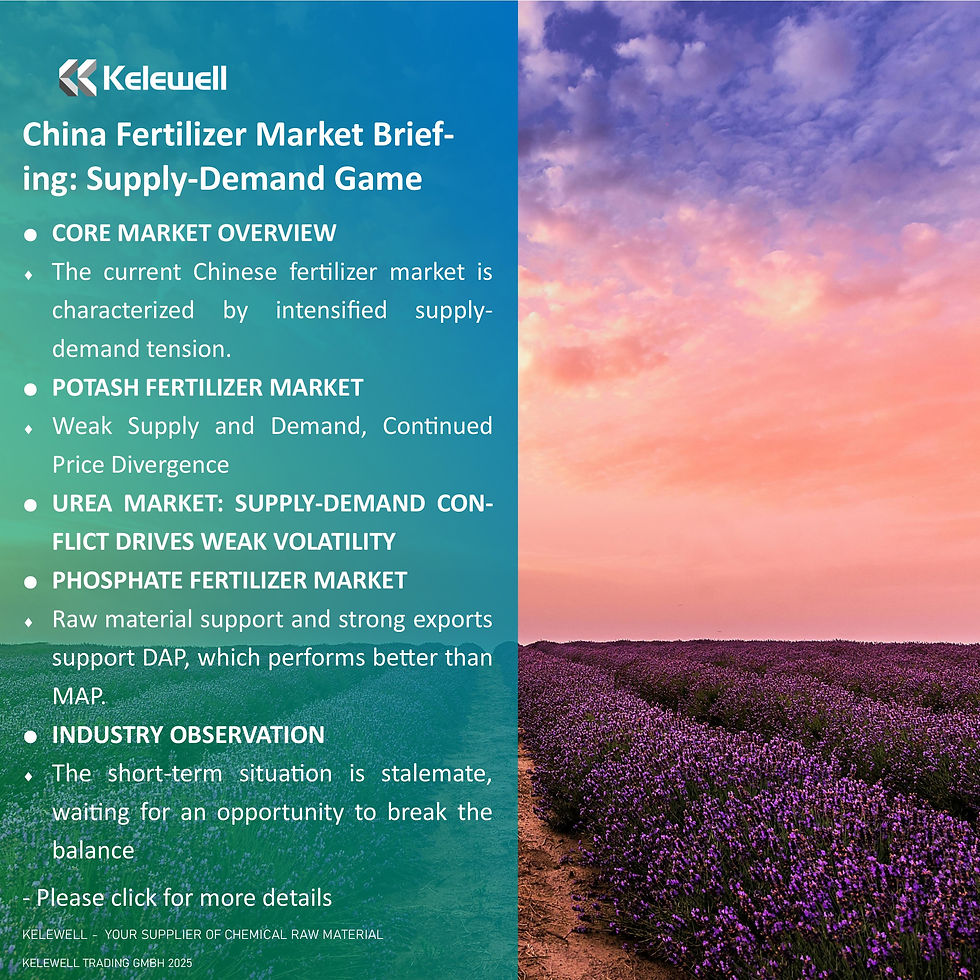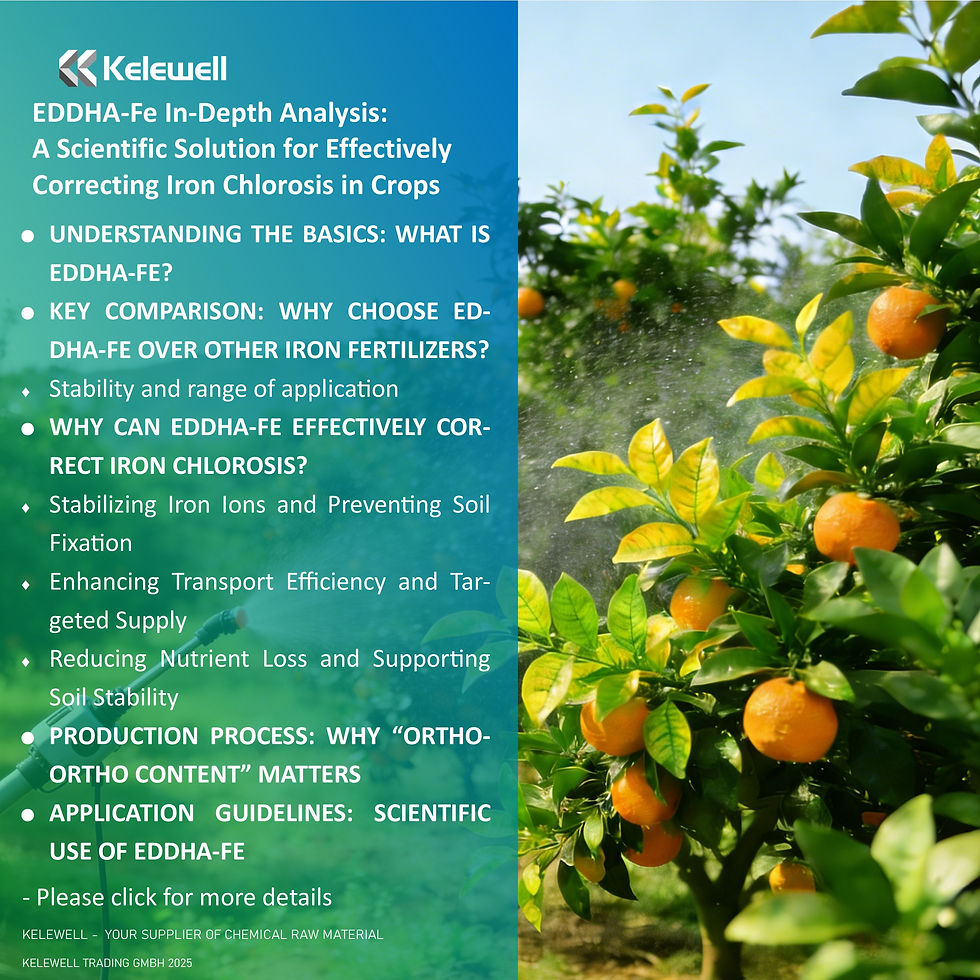China Fertilizer Market Briefing: Supply-Demand Game and Price Divergence
- Fernando Chen

- Aug 4
- 5 min read
Core Market Overview
The current Chinese fertilizer market is characterized by intensified supply-demand tension and continued price divergence.
In the potash sector, both supply and demand are weak: potassium chloride (MOP) faces tight availability and chaotic pricing, while potassium sulfate (SOP) suffers from cost pressures and a “priced-but-not-moving” dilemma.
The urea market is entering a period of mounting pressure, with supply-demand imbalances driving downward price fluctuations.
In phosphates, internal divergence is prominent—monoammonium phosphate (MAP) and diammonium phosphate (DAP) show differing trends, with significant regional variation in raw material dynamics.
Overall, the market continues to grapple with capacity release, weak demand, cost volatility, and policy uncertainty.
I. Potash Market: Weak Supply and Demand, Continued Price Divergence
Recently, the potash market has shown a “steady yet diverging” trend. MOP and SOP display significant differences in supply-demand performance, with the market entering a phase of deep negotiation.
Key Drivers:
Supply Side:
MOP import volumes remain limited. In June 2025, China imported 649,800 tons, a 33.02% year-on-year decrease. Port inventories remain low, with major importers primarily supplying directly to compound fertilizer plants. Circulating inventory is tight. Smaller traders quote inconsistently due to inventory discrepancies, and some products are out of stock.
SOP is burdened by high MOP prices—most Mannheim-type SOP producers are operating at a loss, and national operating rates have dropped to around 50%.
Demand Side:
Downstream compound fertilizer plants are operating at only 30–40% capacity. Autumn fertilizer production has started slowly, with a “buy-as-needed” strategy dominating. There is low acceptance of high-priced potash, further worsening market stagnation.
Market Status:
MOP:As of late July, 62% white MOP port prices ranged from CNY 3,150–3,450/ton, with border trade quotes at CNY 3,150–3,250/ton. The high-price segment is chaotic. Mainstream importers are releasing limited low-price volumes, and traders’ inventories are low, leading to higher quotes.
SOP:Mannheim-type 52% powder SOP ex-factory prices are at CNY 3,850–4,050/ton, with limited sales even after CNY 50/ton discounts. In-plant inventories are slow to move. Resource-based SOP prices are stable, but weak demand is limiting upward momentum.
Trend Outlook:
In the short term, with limited restocking and weak downstream demand, a dual-tier price structure is likely to persist. MOP dynamics will depend on port arrivals, while SOP will hinge on the cost–demand balance.
Over the longer term, with 67% import dependency, China's potash prices will be shaped by production and shipping conditions in major exporting countries (e.g., Russia, Belarus). The timing and strength of demand recovery may determine the extent of price rebound.
II. Urea Market: Supply-Demand Conflict Drives Weak Volatility
China’s urea market is entering a pivotal stage, with mounting supply-demand tension and ongoing weak volatility.
Price Performance and Drivers:
Excess Supply:
Theoretical industry capacity has surpassed 80 million tons, with output expected to grow 7.31% in the second half of the year. The oversupply is hard to reverse.
Despite shutdowns in Northwest and Shandong plants, restarts in Henan and Shaanxi are ongoing. Daily output may drop below 190,000 tons, but remains high.
Weak Demand:
The market remains in a seasonal low. Compound fertilizer production is subdued due to strong phosphate and potash prices. Procurement remains price-sensitive.
In high-phosphorus autumn blends, ammonium chloride is increasingly used as a substitute, further suppressing urea demand.
Global Linkage:
India plays a pivotal role. A tender ending on August 4 aims to import 2 million tons, supported by strong monsoon-driven demand. The expected bid price is slightly higher than the previous round.
In markets like Brazil, falling corn prices and rising urea prices are squeezing purchasing power.
Chinese export offers are exerting pressure on low-end markets, but India's demand and September expectations may offer short-term support.
Market Focus Ahead:
In the short term, supply-demand conflict will remain dominant. In the medium to long term, autumn procurement, concentrated agricultural demand, and export activity could offer support. A mild price rebound is possible.
However, during the off-season inventory period, export policy tightening may occur, possibly leading to renewed price declines.Key factors to watch: India’s tender results, China’s export policy adjustments, and the timing of autumn fertilizer demand.
III. Phosphate Market: MAP and DAP Diverge; Uneven Raw Material Support
From late July to early August, the phosphate fertilizer market shows clear divergence: MAP is weak, while DAP remains strong. Raw material dynamics vary significantly by region.
Domestic Market:
MAP:In Hubei, 55% powder MAP ex-factory prices are at CNY 3,400–3,420/ton. New order signing has slowed, trade sales are sluggish, and producers focus on fulfilling pending orders. 73% industrial-grade MAP is quoted at CNY 6,000/ton, but demand is weak and deals are limited.
DAP:64% granular DAP in Hubei is priced at CNY 3,800–3,850/ton. Producers are focused on exports, with most of the first-stage quota already signed and shipments accelerating. In India, DAP import prices are at USD 810/ton CFR, and market sentiment remains optimistic.
Raw Material Market Dynamics:
Phosphate Rock:In Chengde (Hebei), prices rose by CNY 10/ton due to environmental inspections and production halts, tightening northern supply. Southern prices remain stable, with good demand for mid-to-low grade ore supported by autumn fertilizer production and exports.
Sulfur:Port inventories have built up to 2.56 million tons, with spot prices at CNY 2,370/ton holding flat. The market is in a stand-off over autumn orders. In Shandong, tight supply of liquid sulfur from refiners keeps prices high (CNY 2,350–2,450/ton).
Sulfuric Acid:Regional divergence is significant. Prices in Guangxi and Yunnan have risen CNY 30–40/ton due to supply-demand mismatch. Shandong prices are slightly down due to weak demand. In Yunnan, 98% smelting acid is delivered at CNY 720–750/ton.
Synthetic Ammonia:Prices are rising due to increased downstream demand and tighter supply. Regional price variations are significant, with short-term supply appearing tight.
International Market Summary:
China’s DAP exports remain strong, with first-stage quotas nearly completed. International prices remain high, supporting the domestic market.
Phosphate rock imports are stabilizing, with steady procurement by leading companies. Buyers remain cautious with Egyptian-origin materials.
IV. Industry Observation and Future Outlook
Short-Term Trends:
Potash:Price to remain volatile under tight supply-demand balance. Key variables include MOP port arrivals and SOP’s cost pass-through capability.
Urea:Export policy and Indian tenders are short-term drivers. Overcapacity remains a long-term constraint, making strong price increases unlikely.
Phosphate:DAP remains export-driven and resilient. MAP is dragged by weak domestic demand. Raw material cost vs. demand dynamics will determine price direction.
Key Watch Points:
Results and price implications of India’s urea and DAP tenders;
Changes in China’s export policies, especially for urea and DAP quotas;
Timing of autumn fertilizer demand and compound fertilizer plant operating rates;
Capacity release and seaborne arrivals from global potash producers.
Conclusion:
Amid ongoing tension between supply-demand fundamentals and policy expectations, the fertilizer market is likely to remain divergent and volatile in the short term. A turning point in demand or policy may be needed to shift the current balance.
Attention: The above information is for commercial reference only due to the diversity of information collected, and Kelewell is not responsible for the authenticity of the data.




Comments